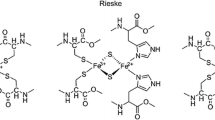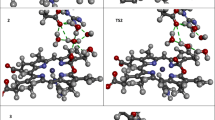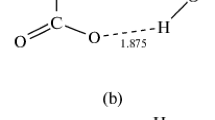Abstract
Quantum-chemical calculations have been performed by an iterative extended Hückel method to examine the electronic structures for chlorhemin and the product from its interaction with aniline, while an interpretation is also given of data obtained previously by 57Fe Mössbauer spectroscopy. The results indicate that chlorhemin reacts with aniline to give low-spin six-coordinated ferriporphyrins (hemochromes). The quadrupole splittings ΔEQ and the s-electron densities at the 57Fe nuclei have been calculated for bis-aniline hemochrome and hemin, as these determine the isomeric shifts. Two forms of calculation are compared with experiment: from the use of one-term functions of Slater type for the Fe AO and by the use of multiexponential expansions. Modified calculations have been performed on the isomeric shifts in the complete bases of all the Fe AO, which enables one to eliminate the usual procedure for orthogonizing the core s electrons. The MO have been classified and the orbital interactions have been analyzed for both compounds.
Similar content being viewed by others
Literature cited
V. I. Khleskov, B. N. Burykin, and R. É. Garibov, “A quantum-chemical analysis of the electronic structures for bis-imidazole iron porphyrins in comparison with Mössbauer data,” Teor. Eksp. Khim., 21, No. 2, 146–153 (1985).
A. Trautwein, R. Zimmermann, and F. E. Harris, “Molecular structure, quadrupole Splitting, and magnetic susceptibility of iron in deoxygenated myoglobin and hemoglobin,” Theor. Chim. Acta, 37, No. 2, 89–104 (1975).
A. Trautwein and F. E. Harris, “Calculated electron densities and experimental isomer shifts of 57Fe in the deoxy-and CO-compounds of mygolobin and hemoglobin,” ibid., 38, No. 1, 65–69 (1975).
I. D. Gadaskina, “Aromatic nitro and amino compounds and their derivatives,” in: Toxic Substances in Industry, edited by I. V. Lazarev [in Russian], Vol. 2, Khimiya, Leningrad (1976), pp. 281–283.
R. É. Garibov, A Mössbauer Study of Some Iron Porphyrin Systems: PhD Thesis [in Russian], Moscow (1982).
M. Zerner and M. Gouterman, “Porphyrins. 4. Extended Hückel calculations on transition metal complexes,” Theor. Chim. Acta, 4, No. 1, 44–63 (1966).
L. V. Vilkov, V. S. Mastryukov, and N. I. Sadova, Determining the Geometrical Structures of Free Molecules [in Russian], Khimiya, Leningrad (1978).
M. Zerner, M. Gouterman, and H. Kobayashi, “Porphyrins. 8. Extended Hückel calculations on iron complexes,” Theor. Chim. Acta, 6, No. 5, 363–400 (1966).
A. M. Karo, F. McMurphy, and R. K. Nesbet, “Limited-basis-set analytic self-consistent wave functions for transition-metal atoms,” Phys. Rev., 165, No. 1, 123–126 (1968).
L. M. Dautov, D. K. Kainov, Zh. I. Adymov, et al., The Electronic Structures of Free Atoms [in Russian], Preprint, Institute of Nuclear Physics, Academy of Sciences of the Kazakh SSR, No. 1–82, Alma Ata (1982).
M. Wolfsberg and L. Helmholtz, “The spectra and electronic structure of the tetrahedral ions MnO −4 , CrO −−4 and ClC −4 ,” J. Chem. Phys., 20, No. 5, 837–843 (1952).
E. V. Mielczarek, “The isomer shift calibration constant in 57Fe,” J. Phys. Suppl. 3, 40, 508–510 (1979).
K. J. Duff, “Calibration of the isomer shift for 57Fe,” Phys. Rev. B, 9, No. 1, 66–72 (1974).
A. Trautwein, F. E. Harris, A. J. Freeman, and J. P. Desclaux, “Relativistic electron densities and isomer shifts of 57Fe in iron-oxygen and iron-fluorine clusters and of iron in solid noble gases,” ibid., 11, No. 11, 4101–4105 (1975).
V. I. Khleskov and K. A. Kon'kov, “Information on programs for quantum-chemical calculations on the electronic structures of molecular systems,” Zh. Strukt. Khim., 23, No. 3, 170–180 (1982).
V. I. Khleskov and K. A. Kon'kov, The IEHM Program for Quantum-Chemical Calculations on the Electronic Structures of Large Molecules by the Extended Hückel Method with Self-Consistency in Charge in a Basis Including up to 240 AO [in Russian], Dep. VINITI No. 2757-82, Moscow (1982).
M. F. Perutz, “Regulation of oxygen affinity of hemoglobin: influence of structure of the globih on the heme iron,” Annu. Rev. Biochem., 48, 327–386 (1979).
M. F. Pettig, P. S. Han, and T. P. Das, “Calculation of hyperfine field and quadrupole splitting in ferriprotoporphyrin IX chloride (hemin),” Theor. Chim. Acta, 12, No. 2, 178–172 (1968).
P. S. Han, M. F. Pettig, D. Ikenberry, and T. P. Das, “Extended Hückel treatment of the Fe57m nuclear quadrupole interaction in hemin,” ibid., 22, No. 3, 261–270 (1971).
C. E. Johnson, “Hyperfine field of 57Fe in hemin,” Phys. Lett., 21, No. 5, 491–492 (1966).
U. Gonser and R. W. Grant, “Mössbauer effect in hemoglobin and some iron-containing biological compounds,” Biophys. J., 5, No. 6, 823–844 (1965).
R. Hoffman, “An extended Hückel theory. 1. Hydrocarbons,” J. Chem. Phys., 39, No. 6, 1397–1412 (1963).
Author information
Authors and Affiliations
Additional information
Translated from Teoreticheskaya i Éksperimental'naya Khimiya, Vol. 22, No. 5, pp. 553–562, September–October 1986.
Rights and permissions
About this article
Cite this article
Burykin, B.N., Khleskov, V.I. & Garibov, R.É. Quantum-chemical study of the electronic structure of the aniline-hemin complex: Mössbauer parameter interpretation. Theor Exp Chem 22, 527–534 (1987). https://doi.org/10.1007/BF00522537
Received:
Issue Date:
DOI: https://doi.org/10.1007/BF00522537




